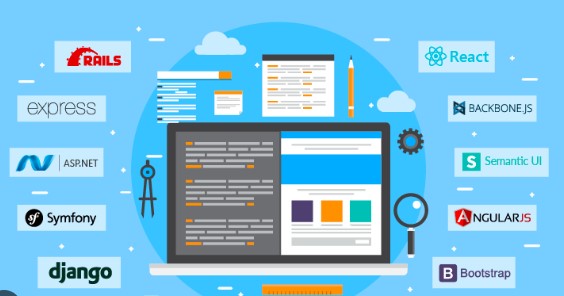Web development frameworks play a pivotal role in streamlining the process of building robust, scalable, and maintainable web applications. With an abundance of frameworks available, each offering unique features, benefits, and use cases, navigating the landscape of web development can be daunting for both beginners and experienced developers alike. In this comprehensive overview, we’ll delve into the world of web development frameworks, exploring their significance, key features, popular options, and best practices for choosing the right framework for your projects.

Understanding Web Development Frameworks
Before we dive into specific frameworks, let’s first understand what web development frameworks are and why they are essential for modern web development.
What are Web Development Frameworks?
Web development frameworks are collections of pre-written, reusable code and tools designed to expedite the process of building web applications. These frameworks provide developers with a structured foundation, standardized practices, and built-in functionalities, allowing them to focus on building application-specific features rather than reinventing the wheel.
Why are Web Development Frameworks Important?
Web development frameworks offer several benefits, including:
- Productivity: Frameworks streamline development tasks, reduce repetitive coding, and provide built-in features, resulting in faster development cycles and increased productivity.
- Consistency: Frameworks enforce best practices, coding conventions, and design patterns, ensuring consistency across projects and facilitating collaboration among developers.
- Scalability: Frameworks often come with scalability features such as modular architecture, database abstraction layers, and caching mechanisms, allowing applications to grow and adapt to changing requirements.
- Security: Frameworks incorporate security measures and protections against common vulnerabilities, reducing the risk of security breaches and enhancing the overall security posture of web applications.
Popular Web Development Frameworks
Now that we understand the importance of web development frameworks, let’s explore some of the most popular options available today.
Frontend Frameworks
1. React.js
React.js is a JavaScript library developed by Facebook for building user interfaces. Known for its component-based architecture and virtual DOM, React.js enables developers to create dynamic and interactive UIs with ease. It is widely used for building single-page applications (SPAs) and is supported by a vast ecosystem of libraries and tools.
2. Angular
Angular is a comprehensive frontend framework developed by Google for building large-scale, feature-rich web applications. It follows the MVC (Model-View-Controller) architecture and offers features such as two-way data binding, dependency injection, and modular design. Angular is particularly well-suited for enterprise-level applications and offers robust support for testing and scalability.
3. Vue.js
Vue.js is a progressive JavaScript framework that is lightweight, flexible, and easy to learn. It is often compared to React.js and Angular but offers a simpler and more approachable syntax. Vue.js is known for its simplicity, reactivity, and versatility, making it an excellent choice for building both small-scale projects and large-scale applications.
Backend Frameworks
1. Express.js
Express.js is a minimalist Node.js framework for building web applications and APIs. It provides a robust set of features for handling HTTP requests, routing, middleware, and template engines. Express.js is highly customizable and is widely used in combination with other libraries and frameworks to create scalable and performant server-side applications.
2. Django
Django is a high-level Python framework for rapid web development. It follows the “batteries-included” philosophy, providing developers with everything they need to build web applications out of the box. Django offers features such as an ORM (Object-Relational Mapping) layer, authentication, admin panel, and templating engine, making it an ideal choice for building complex and data-driven applications.
3. Ruby on Rails
Ruby on Rails, often referred to as Rails, is a popular web application framework written in Ruby. It follows the convention over configuration (CoC) and don’t repeat yourself (DRY) principles, emphasizing simplicity, productivity, and developer happiness. Rails provides a wide range of built-in features, including scaffolding, migrations, and ActiveRecord ORM, allowing developers to build full-featured web applications with ease.
Choosing the Right Framework
With so many frameworks to choose from, selecting the right one for your project can be challenging. Here are some factors to consider when choosing a web development framework:
- Project Requirements: Evaluate the specific requirements of your project, including the type of application, scalability needs, performance considerations, and team expertise.
- Community Support: Consider the size and activity of the framework’s community, as well as the availability of documentation, tutorials, and support resources.
- Learning Curve: Assess the learning curve associated with each framework and determine whether it aligns with your team’s existing skills and expertise.
- Ecosystem and Integrations: Explore the ecosystem of libraries, plugins, and integrations available for each framework, as well as compatibility with existing tools and technologies.
- Performance and Scalability: Examine the performance characteristics and scalability features of each framework, particularly if you anticipate high traffic or complex application requirements.
Best Practices for Web Development with Frameworks
Regardless of the framework you choose, there are some best practices that apply to web development with frameworks:
- Follow Documentation: Familiarize yourself with the framework’s documentation and adhere to recommended practices, conventions, and coding standards.
- Modular Design: Break down your application into modular components or modules to promote code reuse, maintainability, and scalability.
- Testing: Implement automated testing practices, including unit tests, integration tests, and end-to-end tests, to ensure the reliability and correctness of your application.
- Security: Pay attention to security best practices, such as input validation, data sanitization, and protection against common vulnerabilities such as XSS (Cross-Site Scripting) and CSRF (Cross-Site Request Forgery).
- Optimization: Optimize your application for performance, including minimizing load times, reducing server response times, and optimizing resource utilization.
Conclusion
Web development frameworks are essential tools for modern web development, offering developers a structured foundation, productivity enhancements, and scalability features for building robust and maintainable web applications. By understanding the significance of web development frameworks, exploring popular options, and following best practices, developers can leverage the power of frameworks to create innovative and impactful web applications that delight users and meet business objectives.





